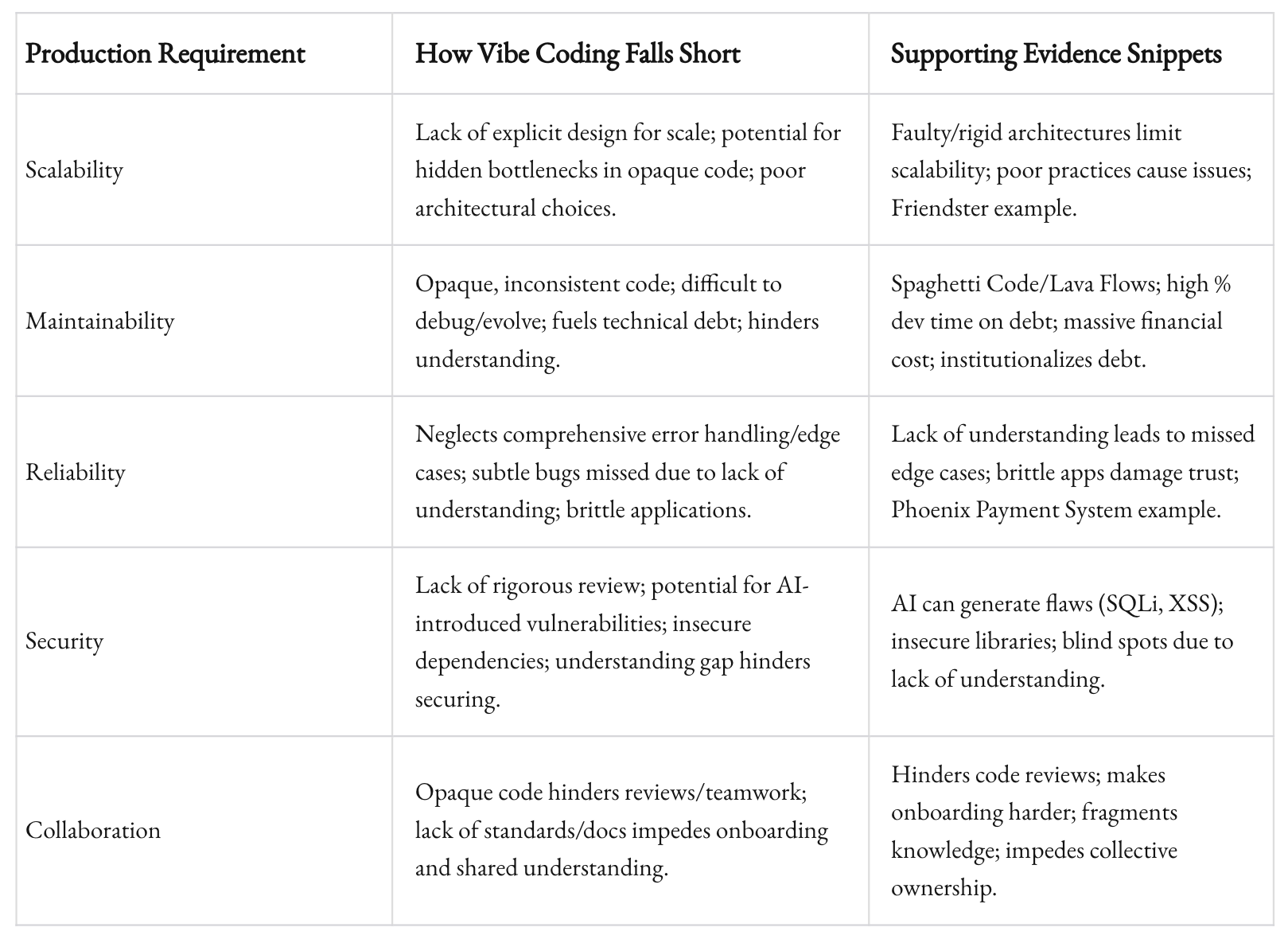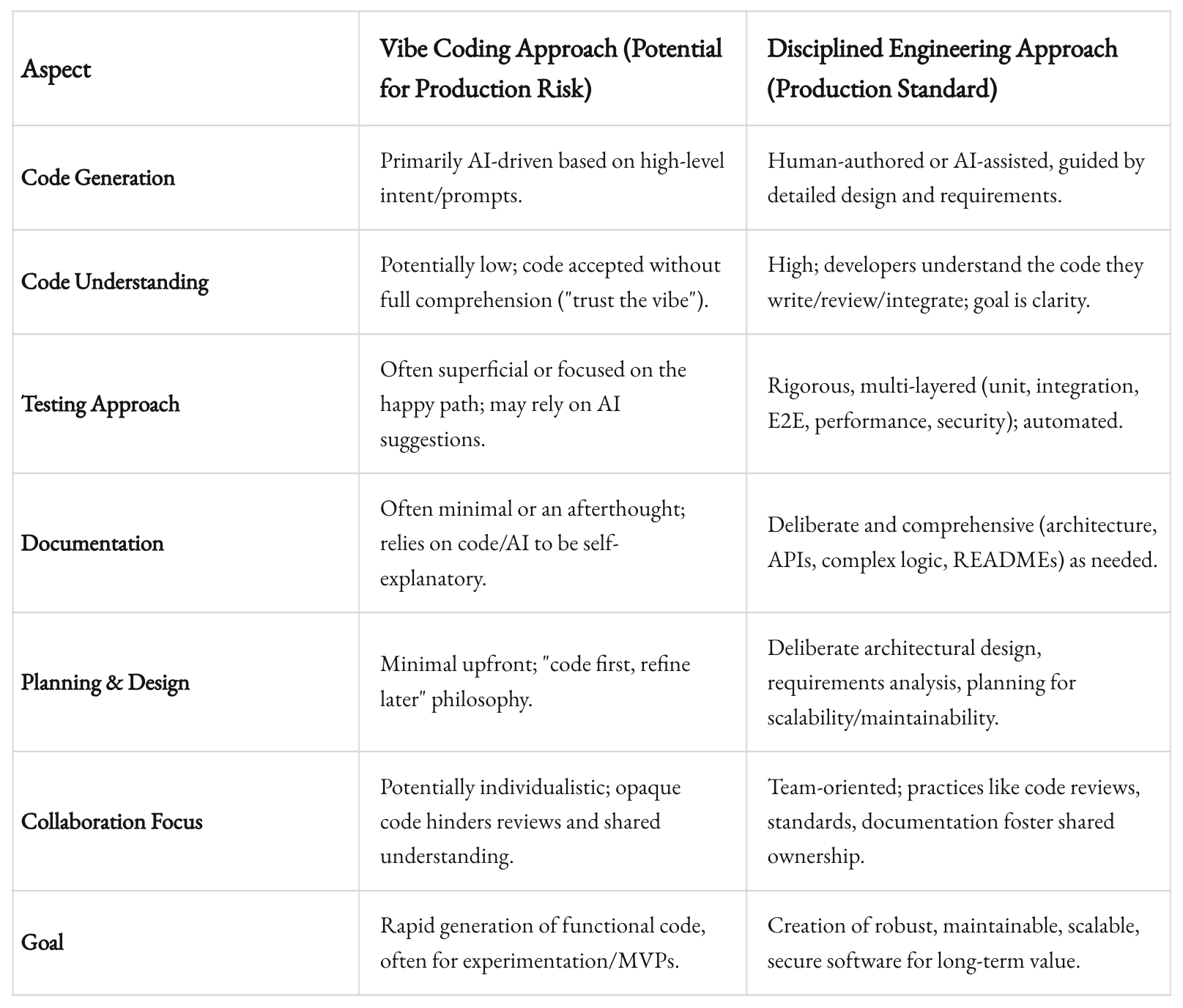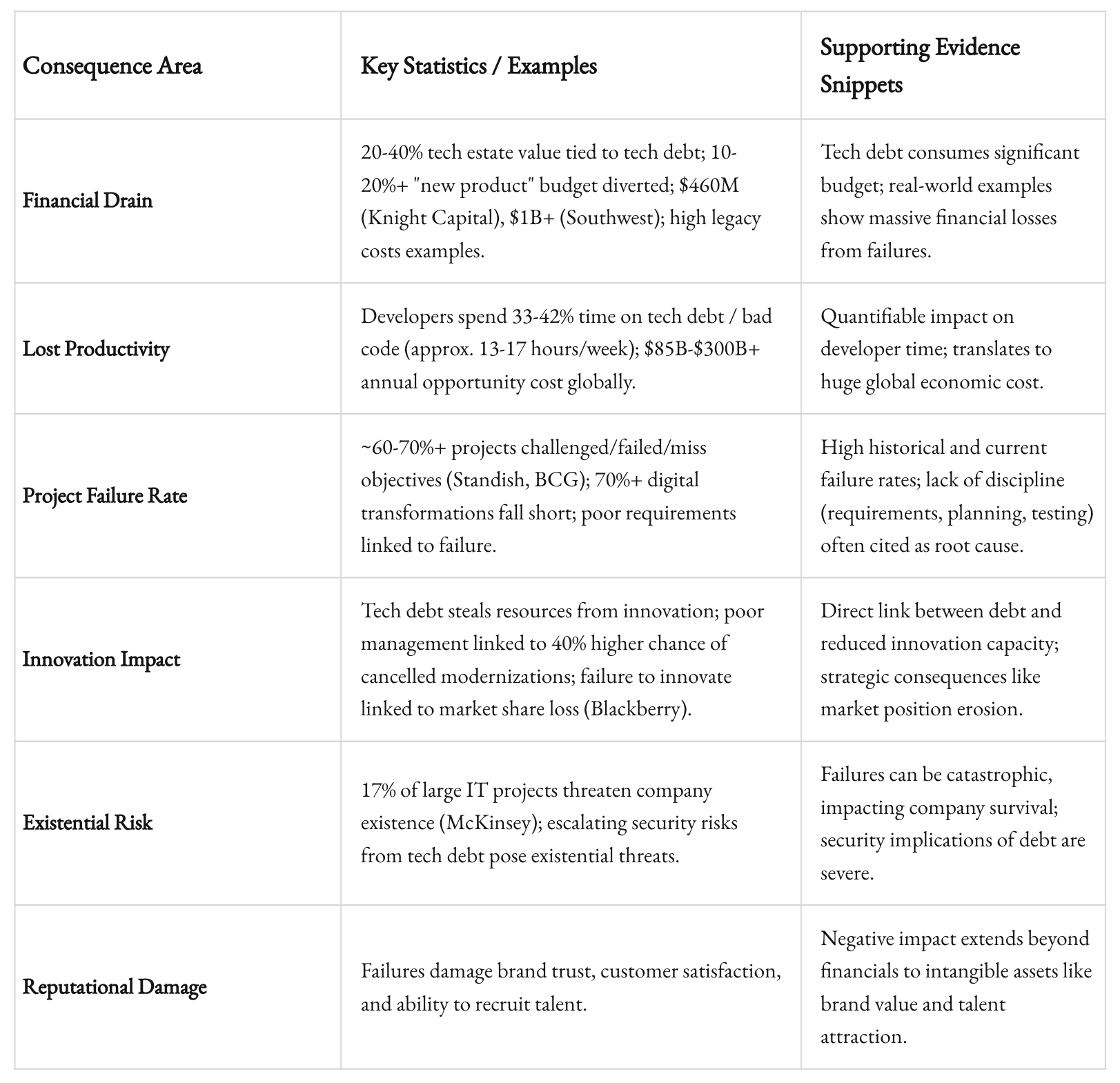Vibe Coding vs. Engineering Discipline: Why Production Apps Can't Run on Vibes Alone
AI coding feels fast, but can it build apps that last? See why solid engineering discipline beats pure intuition for production success!

I. Introduction: The Siren Song of Speed - Can "Vibes" Build Production Fortresses?
The technology landscape perpetually seeks faster, more efficient ways to build software. The current wave of Artificial Intelligence (AI) promises a revolution. Tools capable of translating simple, natural language descriptions into functional code offer an intoxicating vision. Think drastically accelerated development cycles. Lower barriers to entry for creating applications. The tantalizing possibility of conjuring software almost by intuition. This allure resonates powerfully, especially within startups racing to deliver Minimum Viable Products (MVPs) and established businesses striving for greater operational efficiency. Emerging from this zeitgeist is the concept of "vibe coding"—a term capturing the essence of AI-driven, intent-focused development where the "feel" seems to guide the creation process.

However, beneath the appealing surface of rapid generation lies a critical question for tech leaders and founders. These are the stewards of production systems. Can an approach that prioritizes intuition, potentially at the expense of deep code comprehension, truly construct the robust, scalable, and maintainable applications upon which businesses depend? This analysis argues unequivocally: NO. While vibe coding might offer temporary advantages in controlled environments like experimentation or personal projects, relying on it as the primary method for building production-level systems constitutes a high-stakes gamble. It bets against the fundamental principles of sound software engineering. The intuitive "vibes" are insufficient armor. They cannot withstand the harsh realities and relentless pressures of the production gauntlet. This report will dissect the definition and appeal of vibe coding, detail its significant risks in production contexts, contrast it with the imperative of engineering discipline, examine the costly consequences of neglecting rigor, and provide a strategic perspective for leaders navigating this evolving landscape.

II. Decoding "Vibe Coding": Intent, AI, and the Ambiguity of "Good Enough"
The term "vibe coding" gained prominence following its use by AI researcher Andrej Karpathy. It describes a software development approach heavily reliant on AI, particularly Large Language Models (LLMs). The goal is to generate executable code based on high-level descriptions, prompts, or intent expressed in natural language. In this paradigm, the developer's role ostensibly shifts. It moves from meticulous, line-by-line implementation towards guiding the AI, crafting effective prompts, and then testing and refining the generated output. Karpathy characterized his own experience with it as conversational, involving voice commands. He admitted, "It's not really coding - I just see things, say things, run things, and copy-paste things, and it mostly works". This reflects a broader idea that natural language itself could become the "hottest new programming language".

A crucial, defining characteristic distinguishes vibe coding from merely using AI development tools. This distinction was particularly highlighted by AI researcher Simon Willison. True vibe coding, in its most discussed and potentially riskiest form, involves accepting and integrating AI-generated code without the developer achieving a full, deep understanding of its internal workings or implications. As Willison puts it, "If an LLM wrote every line of your code, but you've reviewed, tested, and understood it all, that's not vibe coding in my book—that's using an LLM as a typing assistant". Vibe coding implies a leap of faith. You trust the "vibe" or apparent correctness of the output without comprehensive scrutiny. This gap in understanding is central to the risks associated with its application beyond simple or experimental use cases.
This intuition-driven approach finds its appeal in specific contexts. Speed and ease are paramount there. Rapid prototyping and MVP development are frequently cited examples. Teams can quickly materialize and test ideas with potentially lower initial investment. It aligns with a "code first, refine later" mindset, prioritizing immediate functionality and experimentation over upfront structural rigor. Vibe coding is also promoted as a means for non-programmers or individuals unfamiliar with specific technologies to create simple tools, automate tasks, or build "software for one"—personalized applications for individual needs. Karpathy’s original conception seemed aimed at "throwaway weekend projects", where the consequences of failure are minimal. The core appeal lies in abstracting away the complexities of syntax and implementation details, focusing instead on expressing the desired outcome.

However, even within these limited contexts, the approach is not without acknowledged drawbacks. Vibe coding tools may struggle with novel or technically complex requirements that go beyond standard frameworks. Furthermore, Karpathy himself noted that AI tools are not always capable of fixing the bugs they generate. This requires human intervention and experimentation to resolve issues. This suggests that even for its intended uses, vibe coding is not a fully autonomous solution. It relies on human oversight, particularly when problems arise. The mindset of "good enough for now" or "mostly works", while perhaps acceptable for a prototype destined for the scrap heap, is fundamentally incompatible with the demands of production software. Production software must perform reliably under diverse and often stressful conditions.
III. The Production Gauntlet: Why "Vibes" Crumble Under Pressure
Production environments are the ultimate proving ground for software. They demand far more than just initial functionality. Applications that serve real users, handle valuable data, and underpin business operations must meet stringent criteria. They must be scalable, maintainable, reliable, secure, and support effective team collaboration. Relying on code generated through "vibes"—code that may be opaque, inconsistent, and not fully understood by the team responsible for it—introduces significant and often unacceptable risks across these critical dimensions. An intuition-driven approach, lacking the structure and rigor of disciplined engineering, inevitably falters when subjected to the relentless pressures of real-world operation.

(a) Scalability and Performance Bottlenecks
Production applications must gracefully handle fluctuating loads. They need to accommodate growing user bases and manage increasing data volumes without performance degradation. Scalability isn't an accident. It's a result of deliberate architectural choices and implementation techniques. Code generated by AI based on high-level prompts, without explicit instructions or constraints regarding performance and scalability, is unlikely to incorporate efficient algorithms, optimized database queries, effective resource management, or architectural patterns designed for growth. Faulty or rigid architectures, a common outcome of insufficient planning, inherently limit scalability. Studies suggest that poor architecture practices are a significant cause of scalability issues in applications. Hidden inefficiencies or poor design choices embedded within AI-generated code can create unexpected performance bottlenecks under load. These are notoriously difficult to diagnose and rectify, especially if the team lacks a deep understanding of the code's behavior. The failure of platforms like Friendster serves as a cautionary tale. Inadequate database design and scalability planning led to performance degradation and eventual obsolescence as user growth outpaced the system's capacity.

(b) Maintainability Nightmares & Crippling Technical Debt
Software in production has a long lifespan. It requires ongoing evolution, bug fixing, and adaptation. Maintainability—the ease with which software can be understood, modified, tested, and debugged—is therefore paramount for long-term viability. Code generated by AI, especially if accepted without full comprehension by the development team, poses significant maintainability challenges. Such code may lack stylistic consistency. It might fail to adhere to established coding standards, contain subtle duplications, or manifest as "Spaghetti Code" or "Lava Flows"—impenetrable blocks of logic that developers are afraid to touch. This directly fuels technical debt: the implied future cost of rework incurred by choosing an easy, expedient solution now instead of a better, more sustainable approach that would take longer. Technical debt isn't just theoretical. It has massive financial implications. Industry reports indicate that developers spend a significant portion of their time—estimates range from 33% to 42% of their work week—grappling with technical debt and bad code. This translates into enormous opportunity costs, estimated at $85 billion annually in one report, and diverts substantial portions of technology budgets (20-40% of the technology estate value, according to McKinsey) away from innovation and towards remediation. Unmanaged technical debt creates a drag on development velocity. It increases bug frequency, erodes system quality, and drains resources that could be invested in growth. Relying on "vibe coding" for production risks institutionalizing the creation of this costly debt from day one.

(c) Reliability, Robustness, and Error Handling Deficiencies
Production systems must be dependable. Users and businesses rely on them to function correctly and consistently. This requires not only correct logic for the "happy path" but also robust error handling, graceful degradation, and resilience in the face of unexpected inputs or failures. Vibe coding, often driven by simple prompts describing desired functionality, may easily neglect the complexities of comprehensive error handling, input validation, and fault tolerance patterns like retries or circuit breakers. Developers deploying code they don't fully understand are less likely to anticipate potential failure modes. They are less likely to identify subtle edge-case bugs lurking within the AI-generated logic. This can lead to brittle applications that crash, produce incorrect results, or fail silently under real-world conditions. This damages user trust and potentially causes significant operational problems. The failure of the Phoenix Payment System, attributed partly to massive defects from poor testing, underscores the consequences of inadequate quality assurance.

(d) Security Vulnerabilities: Leaving the Doors Wide Open
Security is non-negotiable for production applications. This is particularly true for those handling sensitive user data or critical business processes. Building secure software requires adherence to secure coding practices, proactive vulnerability management, careful handling of dependencies, and compliance with relevant standards and regulations. Relying on AI-generated code without rigorous security scrutiny and a deep understanding of its potential weaknesses introduces unacceptable risks. An LLM might inadvertently generate code with common vulnerabilities (like SQL injection or cross-site scripting flaws). It might utilize outdated or insecure library versions, or implement flawed authentication or authorization logic. If the development team doesn't fully understand the code they are deploying, they cannot effectively reason about its security implications. They cannot conduct meaningful security reviews. This lack of understanding creates blind spots where vulnerabilities can hide, potentially leading to data breaches, system compromises, and severe reputational or financial damage.

(e) Difficulties in Team Collaboration and Onboarding
Modern software development is rarely a solo endeavor. It's a collaborative effort requiring teams to build, maintain, and evolve systems over time. This necessitates code that is readable, understandable, and consistently structured. This allows multiple developers to contribute effectively. Code generated via "vibes," potentially lacking clear standards, logical structure, or adequate documentation, can become opaque and difficult for other team members to work with. This hinders crucial collaborative processes like code reviews. It makes onboarding new engineers significantly more challenging and time-consuming. A codebase built on individual "vibes" rather than shared conventions and understanding fragments knowledge. It impedes the collective ownership necessary for long-term project health and effective scaling of the development team. Research indicates that projects with well-maintained documentation experience significantly fewer onboarding difficulties.
These risks are not isolated silos; they are deeply interconnected. Poor maintainability makes fixing security vulnerabilities slower and more error-prone. Accumulating technical debt hinders the implementation of scalability improvements. Reliability issues often stem from misunderstood code or inadequate testing, which are harder to address in an opaque codebase. This interconnectedness creates a compounding effect. Shortcuts taken in one area amplify risks across the entire system. The fundamental danger lies not just in the known flaws of AI-generated code but in the "unknown unknowns"—the hidden bugs, security holes, and performance traps that exist precisely because no one on the team possesses the deep understanding required to anticipate or identify them. The perceived short-term velocity gain from vibe coding thus represents a false economy. It is likely overshadowed by the substantial long-term costs of remediation, maintenance, and managing the fallout from failures.

IV. The Engineering Imperative: Building Production Systems That Endure
If intuitive "vibes" are insufficient for the demands of production, what constitutes the necessary foundation? Building software systems that are robust, scalable, maintainable, and capable of delivering sustained value requires a deliberate, disciplined approach. This approach must be rooted in established software engineering principles and practices. This commitment to engineering excellence is not about imposing rigid, bureaucratic processes that stifle creativity. Instead, it involves the consistent application of proven techniques. These techniques are designed to manage complexity, ensure quality, facilitate effective collaboration, and ultimately enable sustainable development velocity. Paradoxically, true agility and speed in software development emerge from a strong foundation of quality and discipline, not from their absence.

Key principles and practices underpinning production-ready software include: Rigorous Testing Strategies, Systematic Code Reviews, Comprehensive Documentation, Sound Architectural Design & Patterns, CI/CD Pipelines, and adherence to Standards, Simplicity, and Planning.
Rigorous Testing Strategies are far more than a cursory check for obvious errors. Production systems demand comprehensive test suites encompassing various levels: unit tests verify individual component correctness, integration tests ensure components interact as expected, end-to-end tests validate user workflows, and specialized tests cover performance, security, and resilience. Well-written tests serve as executable documentation, build confidence, and provide a safety net for safe refactoring. Automating these tests within Continuous Integration/Continuous Deployment (CI/CD) pipelines is essential for rapid feedback and consistent quality checks. Neglecting testing accumulates "testing debt," a significant contributor to project failures.

Systematic Code Reviews are a cornerstone of quality assurance and team development. Having peers review code changes before integration helps catch defects early, enforce standards, facilitate knowledge sharing, mentor less experienced developers, and improve overall codebase quality. Effective reviews depend on a collaborative culture focused on improving the code, not criticizing the author. Automated tools like linters handle style checks, freeing humans for substantive issues. Focused, smaller reviews often yield more thorough feedback.
Comprehensive Documentation is vital, even with clear code. READMEs, architectural diagrams, API specifications, decision logs, and targeted comments explaining complex logic are crucial. Good documentation aids onboarding, reduces understanding time, facilitates reviews, and supports long-term maintenance. It's an investment, not a chore. Inadequate documentation is a form of technical debt. Well-documented projects face fewer onboarding difficulties.
Sound Architectural Design & Patterns profoundly influence non-functional characteristics like scalability and maintainability. Deliberately choosing appropriate architectural patterns (e.g., microservices, event-driven) and applying design patterns helps manage complexity. Principles like modularity, separation of concerns (e.g., MVC), and SOLID guide developers toward understandable, modifiable systems. Architecture evolves, but requires careful planning to avoid significant architectural debt. As industry wisdom suggests, "If you think good architecture is expensive, try bad architecture".

CI/CD Pipelines are fundamental to modern agile development. Continuous Integration (CI) involves frequent merges to a central repository, triggering automated builds and tests. Continuous Deployment/Delivery (CD) automates releases, deploying validated changes quickly and reliably. These pipelines create rapid feedback loops, reduce manual effort/errors, enable smaller/safer releases, and increase velocity and reliability. Lack of automation is a form of technical debt.
Standards, Simplicity, and Planning form the bedrock. This includes adhering to coding standards for consistency, actively managing complexity, avoiding premature optimization, using version control effectively, and engaging in thoughtful planning and requirements management. Striving for simplicity makes systems easier to understand, test, and maintain. Discipline is arguably the most crucial tool for a software engineer.
It is critical to recognize that these practices form a synergistic system. Good architecture makes code easier to test and review. Test suites enable safe refactoring. Code reviews uphold standards and improve tests. CI/CD pipelines automate tests and reviews. Documentation provides context. This interplay creates a virtuous cycle: quality begets quality, leading to more resilient systems. Furthermore, this disciplined approach enables sustainable speed. Shortcuts seem faster initially but cause delays later. Investing in quality upfront reduces friction, minimizes failures, and builds confidence for rapid iteration. It embodies "To go faster, slow down". Finally, practices like code reviews and documentation highlight the vital human element—knowledge sharing, mentorship, collaboration, and collective ownership are essential for building complex systems effectively.

V. The Reckoning: Consequences of Cutting Corners
The decision to prioritize perceived short-term speed over long-term engineering discipline is not merely a technical tradeoff. It represents a significant business gamble. The consequences can be severe and far-reaching. When rigor is neglected—whether through unstructured approaches like vibe coding applied inappropriately, or simply poor engineering practices—the negative impacts inevitably cascade outwards. These manifest as direct financial drains, project delays and failures, erosion of customer trust and market reputation, stifled innovation, and can even threaten business viability. Industry data paints a stark picture.

The Crushing Weight of Technical Debt is a primary consequence. This debt, the future cost of rework from suboptimal choices, imposes a substantial financial burden. Studies quantify this dramatically. Developers report spending 33% to 42% of their work week battling technical debt and bad code. This lost productivity translates into massive opportunity costs, potentially $85 billion annually or more. Organizations dedicate significant portions of their tech budgets—often 10-20% for new products, representing 20-40% of the entire technology estate's value according to McKinsey—just to managing existing debt. This directly cannibalizes resources from innovation and growth.
The High Rate of Project Failure is another stark reality. The software industry grapples with high failure rates (projects late, over budget, undelivered, or cancelled). The Standish Group's CHAOS reports consistently highlight this challenge, with figures suggesting around 66% of projects face partial or total failure. Other studies corroborate this, citing high failure rates for digital transformations (often over 70%) and projects missing objectives. Crucially, analyses point to root causes linked to lack of discipline: poor requirements, inadequate planning, insufficient user involvement, deficient testing. Approaches like vibe coding, potentially shortcutting these areas, align dangerously with these failure patterns. McKinsey links poor tech debt management to a 40% higher chance of IT modernization project cancellation.

Cautionary Case Studies bring statistics to life. Knight Capital Group lost $440-460 million in under an hour due to a deployment glitch linked to legacy systems and tech debt. Healthcare.gov's initial launch failure stemmed from poor architecture and debt, costing hundreds of millions to fix. Friendster failed largely due to inability to scale, a consequence of poor initial design. Netscape's rewrite attempt (Netscape 6) to address debt took too long and failed. Blackberry's decline is linked partly to unmanaged tech debt hindering innovation. The Phoenix Payment System deployed with major defects due to poor requirements and testing. Heathrow's Terminal 5 baggage system suffered costly failures due to bugs. Southwest Airlines faced operational meltdown attributed to outdated systems and tech debt, costing over $1 billion. These examples show cutting corners on architecture, testing, scalability, and debt management leads to consequences from financial loss to business failure.
These examples transform "poor engineering" from a technical concern into a quantifiable business risk. The patterns are clear: neglecting architecture and scalability, allowing unchecked technical debt, and failing on requirements and testing are pathways to failure. Vibe coding, without accompanying discipline, risks replicating these patterns. Consequences extend beyond direct costs to damaged reputation, eroded trust, recruitment difficulties, and, as McKinsey noted, potential existential threats for the company from large IT project failures.

VI. The Leader's Compass: Navigating from Vibes to Value
For technology leaders and company founders, choices around software development methodologies are strategic. They have profound implications for the business trajectory. Embracing shortcuts like relying solely on vibe coding for production might offer illusory speed. But this approach fundamentally undermines long-term, sustainable value creation. Conversely, deliberately fostering engineering excellence demands upfront investment and consistent effort. Yet, it builds the essential foundation for durable innovation, genuine agility, and organizational resilience.

Business Implications extend beyond code. Technical debt accumulation, often from undisciplined practices, significantly drags innovation. Resources are consumed fixing past mistakes instead of building new capabilities. Actively managing debt can reverse this; some companies free up 50% of engineer time for value-adding work. True business agility and sustainable speed-to-market emerge from clean, maintainable codebases enabling predictable iteration, not chaotic shortcuts. The initial velocity of vibe coding can dissipate, replaced by long-term delays. Poor software quality also means higher operational costs (support, incidents) and heightened business risks (security, compliance, downtime). Investing in engineering discipline is critical operational risk management. Technical debt should be managed as a tangible liability impacting financial health and strategy. Robust technical health correlates positively with business performance.
Team Productivity, Morale, and Scaling are deeply affected. Constantly battling technical debt and brittle code is frustrating and demoralizing for engineers. This impacts productivity and leads to burnout and high attrition. Skilled engineers often leave first ('brain drain'), exacerbating problems. Conversely, leadership that values quality and addresses debt fosters higher morale and engagement. Disciplined practices (standards, docs, reviews) are essential for collaboration, knowledge sharing, onboarding new members, and scaling the organization effectively without chaos. Discipline fosters predictability in estimates and timelines, building trust across the business.

The Leader's Role is pivotal in setting the tone for excellence. Software quality reflects leadership priorities. Leaders must recognize the strategic business importance of technical debt and engineering practices. Key responsibilities include: Acknowledge and Prioritize Debt by making its measurement and management visible at the C-level, integrating it into planning, and differentiating strategic vs. reckless debt. Allocate Resources by dedicating time, budget, and capacity to address debt, refactor, and improve practices. Set Clear Standards & Expectations by defining quality, implementing guidelines, and championing discipline. Foster a Culture of Quality that values craftsmanship, continuous improvement, psychological safety, and empowers teams. Measure What Matters by focusing beyond feature velocity to include system health, quality, and process efficiency metrics (DORA metrics, debt levels). Lead by Example through consistent commitment to long-term thinking, quality, and sustainable practices. Leadership often determines whether an organization succumbs to debt or builds for sustained success. Allowing vibe coding into production is ultimately a leadership choice about risk, quality, and strategy.

VII. Build to Last - Engineering Excellence in the Age of AI
The rapid advancements in AI offer compelling tools. They promise to accelerate software development. The allure of approaches like "vibe coding"—generating code swiftly from natural language intent—is understandable in a competitive landscape demanding speed and innovation. However, this analysis has demonstrated that relying on intuition, vibes, and potentially opaque, unscrutinized code as the primary basis for building production software systems is a perilous strategy. It courts instability. It fosters crippling technical debt. It increases security exposure and ultimately undermines business goals. The perceived short-term velocity gains are often illusory. They are quickly eroded and overshadowed by the significant, compounding long-term costs associated with maintaining, debugging, and evolving fragile, poorly understood systems.
Production software is the bedrock of modern business. It demands qualities that do not spontaneously emerge from high-level prompts or automated suggestions alone. Resilience, scalability, maintainability, security, and predictability are the hard-won results of deliberate, disciplined software engineering practices. Rigorous automated testing provides safety nets. Systematic code reviews ensure quality and share knowledge. Thoughtful architectural design anticipates future needs. Clear documentation enables collaboration. Proactive management of technical debt preserves future agility. These practices are not bureaucratic impediments. They are the essential scaffolding supporting sustainable velocity, innovation, and the creation of lasting value. They enable teams to build systems that can reliably evolve and scale.

For tech leaders and founders working through the AI era, the path forward requires wisdom and foresight. The challenge is not to resist powerful new AI tools. It is to integrate them intelligently within a robust framework of engineering excellence. AI can serve as a powerful assistant, augmenting productivity and handling boilerplate tasks. But it cannot replace the critical need for deep understanding, rigorous validation, and human accountability in creating production systems. The optimal strategy involves leveraging AI to enhance, not circumvent, engineering discipline. Leaders must champion a culture where quality is paramount, where technical debt is a strategic liability actively managed, and where engineering teams are empowered, supported, and held accountable for building software designed to endure. Ultimately, investing in sound engineering principles is a direct investment in the future agility, reliability, competitiveness, and long-term success of the business. In the age of AI, the imperative remains: don't just vibe; build with intention, discipline, and foresight. Build to last.



